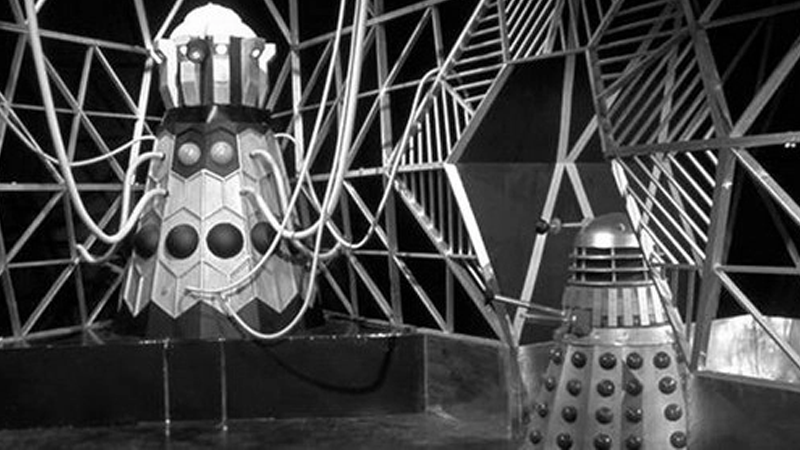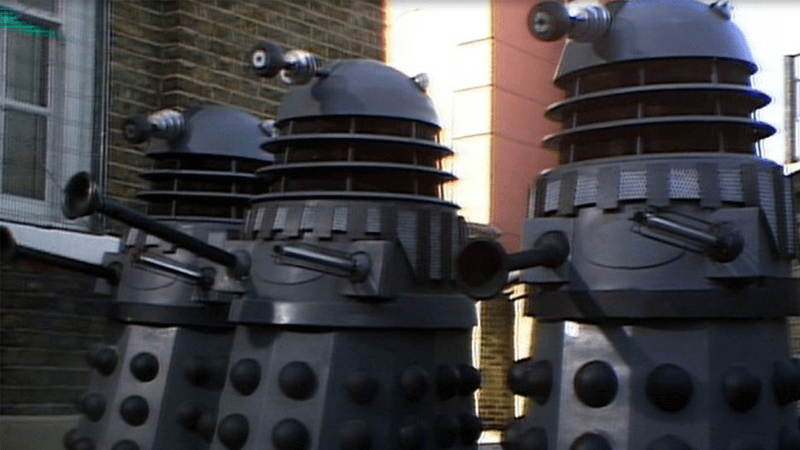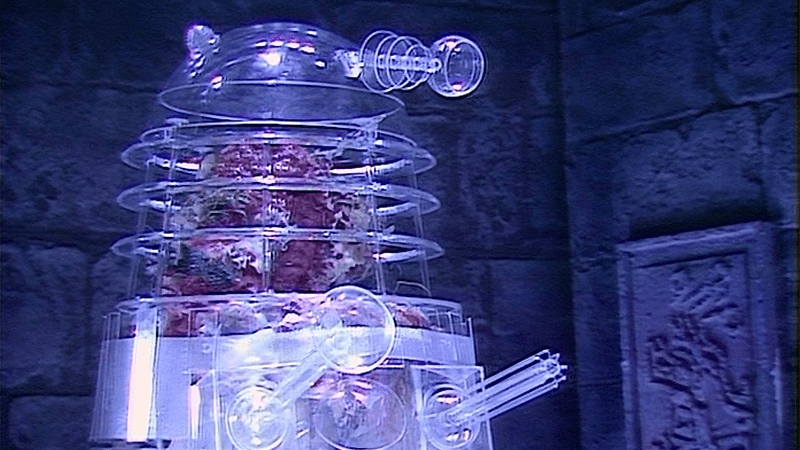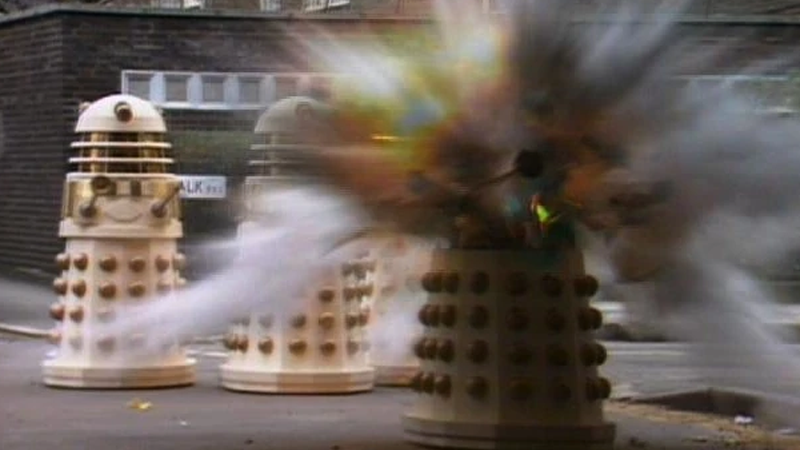In 2021, Doctor Who finally returns with “Revolution of the Daleks,” and from what we know of it so far, seems like it’s going to give us a brand new faction of human-made Daleks…that the actual Daleks are none too pleased with. But this is far from the first time the pepperpots have come to blows with their own kind.
Whether it’s the original planetary war between the Thals and the Kaleds that created the monstrous mechanicals in the first place, or even heretical purges like the Cult of Skaro’s Human-Dalek hybridisation experiments, Daleks are no stranger to the concept of war in the name of ideological and genetic purity. But the classic Doctor Who creatures are most fascinating, not when they’re questioning who is the Most Dalek among them, but instead concepts of allegiance and loyalty that break out of consensus to form conflict. Dalek vs. Dalek in an all-out extermination battle of civil war.
[referenced id=”1583805″ url=”https://gizmodo.com.au/2020/11/our-human-heroes-fight-a-dalek-apocalypse-in-the-full-trailer-for-the-doctor-who-new-years-special/” thumb=”https://gizmodo.com.au/wp-content/uploads/2020/11/30/f9qvdh7grfsnwjfdekmh-300×169.jpg” title=”Our Human Heroes Fight a Dalek Apocalypse in the Full Trailer for the Doctor Who New Year’s Special” excerpt=”It’s here: your first full look at the upcoming Doctor Who holiday special, “Revolution of the Daleks.” It’s going to be a big one.”]
Through tie-in fiction — like the original TV21 Dalek comics or even their first appearance in the Doctor Who tie-in novels of the ‘90s, War of the Daleks — the idea of Dalek Civil war has been tackled before, and twice in the show itself already. That’s before New Year’s Day’s “Revolution” seemingly adds a third. The first example is perhaps the one the festive special is most destined to emulate, considering the teases of man-made Daleks being something true Daleks are opposed to. The second is perhaps one of classic Doctor Who’s boldest storytelling gambits with its most iconic villains — an evolving back story that strung together their serials across years of otherwise standalone stories.

Let’s go over the first, and arguably most important Civil War to draw comparisons to the latest, “Evil of the Daleks” — the 1967 serial, starring Patrick Troughton’s second Doctor. It was almost the last Dalek story, sending the species out with a climactic, destructive bang. Introducing the concept of the Daleks being ruled by an Emperor for the first time, “Evil” sees the Doctor and his companion Jamie abducted by the Emperor’s forces to help create the perfect Dalek, by distilling the essence of their greatest enemy: humanity. By studying the “human factor,” which the Daleks believed was what lead their previous plans to invade the galaxy (“The Daleks Master Plan”) to fail, the Dalek Emperor believed he could create an opposing “Dalek factor” that could be imbued in them to enhance their abilities.
Turns out, trying to press-gang the Doctor into making his greatest foe even deadlier doesn’t really work though. Sensing the subterfuge of the Emperor, the Doctor distilled the “human factor” and supplanted it into three test Daleks, before surreptitiously rigging a gateway on Skaro to infect every Dalek that passed through it with the factor. Once they did, Civil War was inevitable: “human factor” Daleks began questioning their orders and doctrines, rising up against the Daleks still loyal to the Emperor.

What followed was a near-complete massacre that even the Doctor thought might be the final end of their nemesis; the Dalek capital on Skaro was laid to waste, the Emperor himself presumed dead, and Dalek society completely fractured…but not completely broken. The Doctor wouldn’t see his foes again for another five years (and with a new face), when in “The Day of the Daleks” their command structure had been completely rebuilt after the seeming loss of their Emperor.
[referenced id=”949310″ url=”https://gizmodo.com.au/2016/06/the-gizmodo-guide-to-doctor-who/” thumb=”https://gizmodo.com.au/wp-content/uploads/2015/06/06/eqxqserqwgixsttfzm9g-300×169.png” title=”The Gizmodo Guide To Doctor Who” excerpt=”For over 50 years, Doctor Who has changed the face of science fiction. With more than 800 episodes, and adventures spanning all of time and space, this icon of television science fiction may seem a little intimidating. But the good news is, it’s really quite simple. Here’s the Gizmodo guide…”]
Rebuilt or otherwise, the Daleks were only setting themselves up for a much larger, more complex second Civil War — one that played a long game in Doctor Who history, forming the backbone of Dalek serials over the late ‘70s and ‘80s. After the Daleks realised that their creator Davros was not a biologically pure Dalek — still retaining his half-Kaled form — and seemingly exterminated him in the climax of the iconic “Genesis of the Daleks,” Dalek society split into two factions: One remained loyal to Davros as their creator figure, while the other sought to establish a pure Dalek society, where Dalek-kind was ruled by its own.

After a devastating war with the Movellans — lethal androids who just so happened to have fabulous taste in extremely shiny, bauble-bedecked wigs — the Dalek factions loyal to Davros sought to rescue their creator and use his genius to win the war. But Davros, being Davros, wasn’t too keen on the idea of the Daleks being lead by a Supreme Dalek, believing himself to be the only being worthy of such a title among his creations.
What followed was a bitter war between what became known as the Imperial Daleks — loyal to Davros — and the Renegade Daleks — the surviving Daleks led by the Dalek Supreme. After Davros created an army of his own through a virus intended to convert Daleks to his cause, both factions were almost immediately decimated in the opening skirmishes of the conflict, as seen in “Resurrection of the Daleks.” Both sides were left to lick their wounds while relentlessly hounding the other.

In “Revelation of the Daleks,” we see Davros put aside the genetic purity of his creations to make new forces out of dead humans, masquerading a funeral service on the planet Necros as a breeding ground for new Imperial forces. By the time the Renegades are seen again in “Remembrance of the Daleks,” their own side remains fractured, differing groups unsure whether or not to keep fighting or side with Davros, until the Seventh Doctor and Ace provided a rallying point for the latest Dalek Supreme to unite the divided Renegades. After all, what Dalek doesn’t want the chance to exterminate the Doctor?
The Supreme’s plan didn’t really work, due to multiple factors. For starters, the Doctor is, well, the Doctor, and is really hard to kill. The other is that Davros’ Imperial forces swooped in during the Supreme’s incursion into early ‘60s Britain in “Rememberance of the Daleks” to lay his opponents low with a new superweapon: the Special Weapons Dalek, a counter the Renegades couldn’t overcome. Their forces laid low and with the Doctor, using a Gallifreyan superweapon of his own in the mystical Hand of Omega, seemingly destroying Skaro and Davros’ forces in the process, the civil war came to an end without a clear victor. Well, other than the Time Lords.

We haven’t really seen the Daleks go at each other’s throats since — although they clearly returned to menace the universe quite often in the meantime (they’re just as hard to kill as the Doctor, really). Even the creation of the controversial new Dalek Paradigm in 2011’s “Victory of the Daleks” was presented as less of an ideological divide and more like true Dalek’s exterminating their willing “lessers” rather than a direct conflict. And so, years down the line with them on the precipice of returning once more, it remains to be seen just how the Daleks will deal with this latest civil skirmish.
Either way, we can, at the very least, expect the one thematic theme that’s united this undercurrent of Dalek history: lots of exploding pepperpots.
[referenced id=”1224011″ url=”https://gizmodo.com.au/2020/06/the-timey-wimey-history-of-doctor-whos-time-war/” thumb=”https://gizmodo.com.au/wp-content/uploads/2020/06/18/s6pdecuhhx3kpauy6exi-300×169.png” title=”The Timey-Wimey History of Doctor Who’s Time War” excerpt=”The Last Great Time War. Those five words have hung over Doctor Who ever since it was revived in 2005: an earth-shattering conflict that saw the Doctor’s people, the Time Lords, pitted against the Daleks. It’s been started, ended, revived, and discussed across Who media for years, and will be…”]
